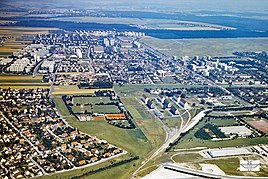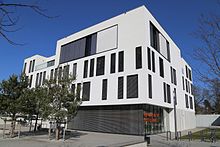Hasenbergl
|
Hasenbergl
State capital Munich
Coordinates: 48 ° 12 ′ 47 ″ N , 11 ° 33 ′ 26 ″ E
|
|
|---|---|
| Area code : | 089 |
|
Aerial photograph 1979
|
|
The Hasenbergl is a quarter in the north of Munich in the northeast of the Feldmoching-Hasenbergl district .
location
Hasenbergl stretches from the A 99 and the city limits to the municipality of Oberschleißheim in the north to Harthof in the south. In the east, Hasenbergl extends to Schleißheimer Straße and borders the Am Hart district . West through the Feldmochinger Anger is separated Feldmoching . Today (2015 depending on the source) 25,000 to 34,387 people live in the district.
origin of the name

From the 18th century on, rabbits were kept for the electoral hunt on a mud hill (size: 8 m × 300 m × 1000 m) four kilometers south of Schleißheim Palace . The clay hill formed in the Ice Age, which today stretches west of the Panzerwiese between Dülferstrasse and Aschenbrennerstrasse, was called Laimpichl in 1697 and was wooded. When rabbits were kept here for stately hunting, the name changed to Küniglberg (1753) and Rabbitberg (1812). In 1809 the ranger's hare hut was first drawn on a map at the Rabbit Mountain. The name Hasenbergl has been in use since around 1900.
history
For military purposes, the Oberschleißheim special airfield was built south of the castle at the beginning of the 20th century . In the nearby Hartelholz forest (north of the Hasenbergl), shelter for the troops and prisoner of war camps were established. In 1937 the barracks of the Frauenholz camp were built. After the end of the war, the Hartelholz camp complex was used as an emergency shelter and refugee camp, which accommodated up to 4,000 people.
The Hasenbergl as a residential area emerged in the early 1950s with the first residential estates. Some of these emerged from the camp complex, but primarily from the nearby Harthof district . From 1957 the "Neu-Hasenbergl" settlement was built on the previously horticultural and agricultural area between Dülferstrasse and Weitlstrasse, Ittlingerstrasse and Rainfarnstrasse. Almost all of the residents built their house themselves with great privation. In 1964 the Diakonie Hasenbergl was founded. The "Siedlung am Hasenbergl" settlement for 18,000 people followed in 1965 to combat Munich's post-war housing shortage. The large housing estate should be "modern, spacious and green". Architects were u. a. Ernst Maria Lang and Ernst Böllemann . Here, seven non-profit housing associations, including Neue Heimat , Südhausbau , GWG and the Evangelische Siedlungswerk in Bavaria , built social and owner -occupied housing for the low-income population. The large settlement complex also expanded later, most recently through the Nordhaide settlement on the Panzerwiese belonging to Harthof .
Until the 1970s, there was a lack of important infrastructure facilities such as schools, churches, businesses or transport links in the Hasenbergl; the district was also considered a social hotspot due to the previous demographic development . The adventure playground Hasenbergl - ABIX was founded in 1971 . In 1979 the Erich Kästner secondary school was established. In 1993 the social facility Lichtblick Hasenbergl was founded. The Lichtblick Hasenbergl is a social institution of the Lichtblick Kinder- & Jugendhilfe founded by Johanna Hofmeir in 1993 , in which children, adolescents and young adults aged 1 to 25 from socially disadvantaged and educationally disadvantaged families in the Munich district of Hasenbergl are supported. The Lichtblick Hasenbergl is a place on the cultural history path Munich .
The quality of life has increased through new construction projects such as the extension of U-Bahn line 2 (1996), student dormitories in the Nordhaide housing estate (2003), the redesign of Goldschmiedplatz (2007), the Mira shopping center (2008) and the Nordhaide school center (2015) has increased significantly in the last few decades and the district has been successfully renewed. The integrated social city concept is jointly responsible for this development . Even today, the Hasenbergl is one of the greenest districts in Munich. In 2007 the Dülferanger was redesigned to a festival meadow. Numerous events take place on the square, including a. the Bürgerfest am Hasenbergl and the Volksfest am Dülferanger take place at the end of July. The 2411 cultural center was opened in October 2012 . The entire complex functions as a district center for around 80,000 citizens in the north of the city and also includes a local supply center. The sculpture "Horse biting itself" by the sculptor Alexander Fischer stands on the adjacent square .
The Hasenbergl is a place on the cultural history trails in Munich .
Architectural monuments
culture and education
- Institutions
- Cultural center 2411
- Diakonie Hasenbergl
- Bright spot Hasenbergl
- Hasenbergl adventure playground - ABIX
- Blue point at Goldschmiedplatz
- Leisure center KistE, Gundermannstr. 77
- schools
- Churches
In the Hasenbergl there are the Roman Catholic churches of the Virgin Mary in Sorrows and St. Nicholas , as well as the Evangelical Lutheran Gospel Church .
Green spaces
The park-like green spaces Dülferanger and Goldschmiedplatz are located in Hasenbergl . The Feldmochinger Anger creates a connection to Feldmoching, the Panzerwiese to Am Hart. In the north lies the hardelwood forest area .
Infrastructure
- The mira district and shopping center is located on the U2 Dülferstraße .
Transport links
Hasenbergl is served by the U2 at the Dülferstraße and Hasenbergl underground stations .
On November 8, 1963, the tram was also extended from Scheidplatz to Harthof and on December 18, 1964 to Hasenbergl (final stop at Goldschmiedplatz ).
Remnants of the tram tracks can still be seen in many places today. B. in the former Wendeschleife at Goldschmiedplatz. The current traffic development plan of the state capital Munich includes the option to extend the currently under construction tram line 23 from Parkstadt Schwabing via the Euro-Industriepark and Neuherbergstrasse back to Goldschmiedplatz. This measure is planned to be implemented by 2015, but so far without secured funding.
Personalities
- Willy Astor , cabaret artist
- Manfred Berger , educator
- Daniel Bierofka , soccer player and coach
- Ursula Buchfellner , actress
- Günther Kaufmann , actor
- Andreas Ottl , soccer player
- Otto Steiner , television producer
- Christine Zierl , actress
Trivia
The Hasenbergl was also known throughout Germany for the fictional birthplace of Erkan from Erkan and Stefan .
See also
literature
- Volker D. Laturell : Feldmoching - The origin and development history of a Munich district. Benno Tins, Munich 1970.
- Volker D. Laturell: Feldmoching-Hasenbergl - the district book for the 24th district with the districts Eggarten, Fasanerie, Feldmoching, Harthof, Hasenbergl, Lerchenau, Siedlung am Lerchenauer See and Ludwigsfeld (with contributions by Reinhard Bauer ). Bavarica-Verlag Bauer, Munich 2000, ISBN 3-935440-01-4 .
- Helmuth Stahleder : From Allach to Zamilapark. Names and basic historical data on the history of Munich and its incorporated suburbs . Ed .: City Archives Munich. Buchendorfer Verlag, Munich 2001, ISBN 3-934036-46-5 .
- Otto Steiner: Foray of a pastor and contemporary on the Hasenbergl . JP Peter, Rothenburg ob der Tauber 1987, ISBN 3-87625-005-6 .
Web links
- District Hasenbergl - state capital Munich
- Br.de: 50 years of Hasenbergl
- Feldmoching-Hasenbergl Culture and History Trail
Individual evidence
- ↑ https://www.br.de/br-fernsehen/sendung/ Zwischen-spessart-und-karwendel/50-jahre-hasenbergl- 100.html
- ↑ https://www.citypopulation.de/php/germany-munchen_d.php
- ↑ http://www.stadtiertel24.de/?Geschichte
- ↑ https://www.tz.de/muenchen/stadt/muenchner-forscher-erklaert-wie-stadtviertel-zu-ihren-namen-kommen-8568573.html
- ↑ KulturGeschichtsPfad - District 24: Feldmoching-Hasenbergl . State capital Munich. Retrieved September 28, 2016.
- ↑ https://www.muenchenwiki.de/wiki/Frauenholz
- ↑ http://www.stadtiertel24.de/?Geschichte/Frauenholz
- ↑ http://www.abendzeitung-muenchen.de/inhalt.im-kulturzentrum-2411-ausstellung-die-siedlung-neu-hasenbergl.4736708b-39f9-4553-ba2e-b0c21c91f045.html
- ↑ https://www.br.de/br-fernsehen/sendung/ Zwischen-spessart-und-karwendel/50-jahre-hasenbergl- 100.html
- ↑ Cindy Drexl: character assassination at Hasenbergl. Image development of a Munich district from 1953 to 1989 in discourse. In: Bayerisches Jahrbuch für Volkskunde 2008, published by the Commission for Bavarian State History at the Bavarian Academy of Sciences. Pp. 51-76
- ↑ https://www.muenchen.tv/mediathek/video/die-stiftung-lichtblick-hasenbergl/
- ↑ https://www.sueddeutsche.de/muenchen/muenchens-macher-im-sozialen-wer-die-stadt-lebenswert-macht-1.1819765-3
- ↑ https://www.br.de/br-fernsehen/sendung/ Zwischen-spessart-und-karwendel/50-jahre-hasenbergl- 100.html
- ↑ https://www.muenchen.de/rathaus/Stadtverwaltung/baureferat/oeffentlicher-raum/Muenchens-Plaetze/duelferanger.html
- ↑ cube-magazin.de ( Memento from December 22, 2015 in the Internet Archive ) (PDF)
- ↑ Transport development plan of the city of Munich (PDF)







